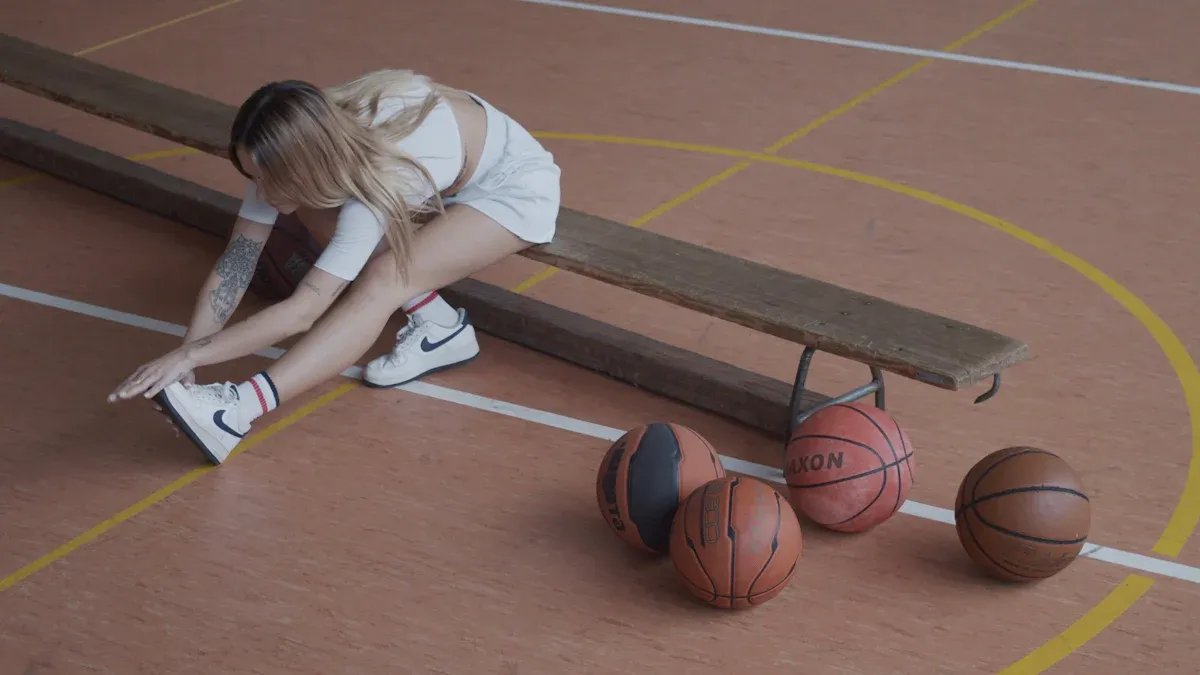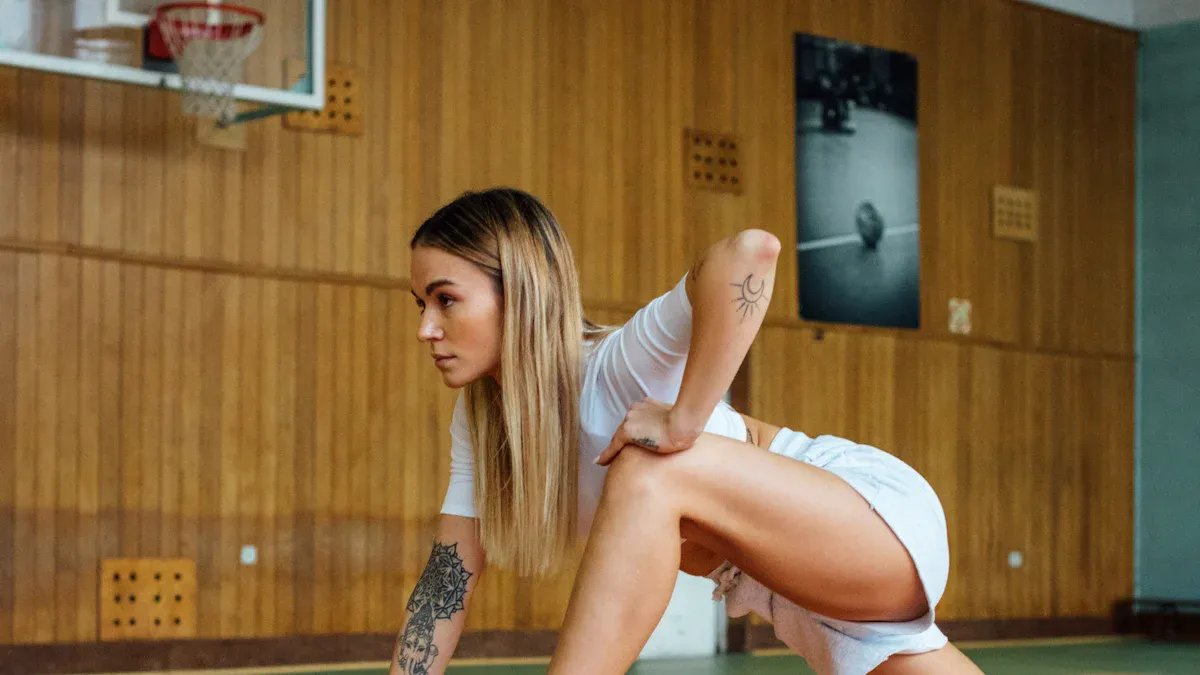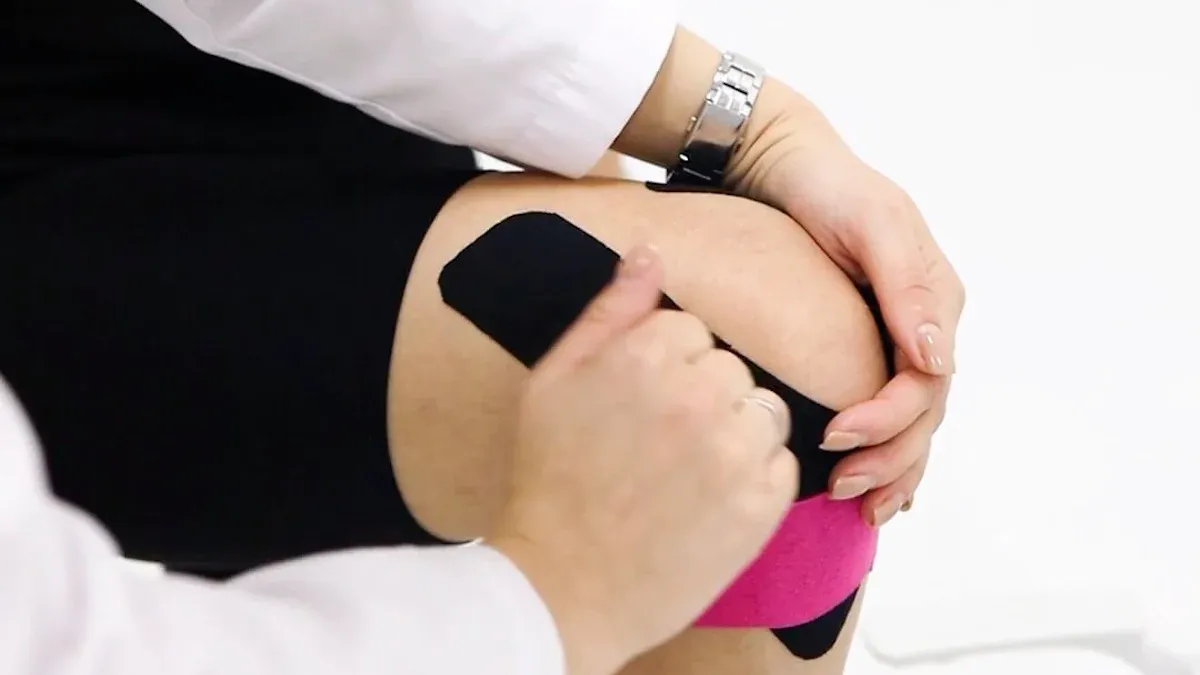
Basketball pushes your body with hard moves like jumping and running, which makes Basketball Injury Prevention crucial. Quick direction changes can also raise your injury risk, so it's important to know what your body needs and stay prepared. Good training, the right gear, and adequate rest are essential for Basketball Injury Prevention and keeping you safe. Staying injury-free not only helps you play better but also enhances your enjoyment of the game. Use these tips for Basketball Injury Prevention to stay in great shape and avoid injuries.
Key Takeaways
-
Basketball injuries often happen from fast moves and contact. Knowing about common injuries like ankle twists and knee problems can help you stay safe.
-
Regular doctor visits and preseason checkups can find weak spots in your body. Fixing these early can make you play better and avoid injuries.
-
Warm-ups and cool-downs are very important. They get your muscles ready to move and help them heal, which lowers injury risks.
-
Wearing the right gear, like good shoes and pads, is important. Proper equipment can stop injuries and keep you protected during games.
-
Pay attention to your body. If something hurts or feels wrong, rest. Ignoring pain can cause worse injuries later.
Understanding Basketball Injuries
Common Causes of Basketball Injuries
Basketball is a fast game with quick moves and sharp turns. These actions, along with physical contact, often cause injuries. Most injuries happen during intense moments like jumping or landing. For example, landing on someone’s foot can sprain your ankle. Ankle sprains are the most common basketball injury. Knee injuries, like ACL tears or meniscus damage, also happen a lot. These often occur during plays near the basket. The middle of the court has the most injuries because it’s very active. Players usually get 6 to 14 injuries for every 1,000 hours of play. Knowing these causes can help you avoid getting hurt.
Frequent Injuries in Basketball
Some injuries happen more than others in basketball. Ankle sprains are the most common, making up 25.8% of injuries in pros. These sprains happen from bad landings or bumping into others. Knee injuries, like ACL tears or patellar tendon problems, are also frequent. They can cause pain and swelling. Other common injuries include jammed fingers, calf strains, thigh bruises, and cuts on the face. Stress fractures, especially in the fifth metatarsal, are also a problem. These injuries show why good training, proper techniques, and rest are important for staying safe.
The Role of Overuse and Recovery in Injury Risks
Overuse injuries happen when you don’t let your body rest enough. Doing too much can hurt muscles, tendons, and joints. This can lead to stress fractures or tendonitis. For example, groin injuries, which are 21.8% of hip injuries, often come from overuse. Rest is key to stopping these problems. Taking breaks, stretching, and easing back into play after an injury can help. Pay attention to pain and fix small issues early to avoid bigger problems later.
Preparation for the Game
Why Preseason Physical Evaluations Matter
Preseason checkups help find risks before you play basketball. These tests check how flexible, strong, and fit you are. Weakness in these areas can raise your injury chances. While they can't always predict injuries, they show what needs work.
|
Evidence Description |
Findings |
|---|---|
|
How useful physical exams are |
|
|
Fitness as a risk factor |
Poor flexibility or strength makes injuries more likely. |
|
Can fitness predict injuries? |
Fitness might predict injuries but not when they’ll happen. |
Fixing these weak spots early helps you play better and stay safe.
Why Regular Health Checkups Help Prevent Injuries
Health checkups are important to keep track of your health. They find problems that might cause injuries later. For basketball players, preseason checkups are extra helpful. They make sure your body is ready for the game.
-
Checkups keep track of your health.
-
They find issues that might lead to injuries.
-
Preseason checkups are great for young basketball players.
By staying on top of your health, you can avoid injuries and keep playing.
How to Keep the Court Safe
A safe court lowers the chance of getting hurt. Before playing, check for wet spots or uneven areas. Wear gear like ankle braces or knee pads to protect yourself. Warm-ups and strength training also prepare your body for the game.
-
Warm-ups and cool-downs help prevent injuries.
-
Gear like braces and pads protect you from falls.
-
Strength training makes your body stronger and safer.
By focusing on safety, you and your team can enjoy the game without getting hurt.
Fitness and Conditioning for Basketball Injury Prevention

Staying Fit All Year
Being active all year helps prevent basketball injuries. Regular exercise makes your body stronger and less likely to get hurt. Training programs can cut injury risks by nearly half. Strength exercises build muscles, while conditioning improves joint support.
Do a mix of cardio, strength, and stretching exercises. Avoid stopping exercise for long periods. Sudden hard workouts after breaks can cause injuries. Staying active keeps your body ready for basketball’s challenges.
Warm-Up, Cool-Down, and Stretching Basics
Warm-ups and cool-downs are key to avoiding injuries. Warm-ups get your muscles ready for action. Cool-downs help your body recover after playing. Stretching makes muscles flexible and less stiff, lowering injury chances.
Studies show warm-ups and stretching prevent many muscle injuries. Muscle injuries make up over 30% of sports injuries. Doing these routines before and after basketball keeps you safer and boosts performance. Stretching also teaches you how to avoid injuries on the court.
Healing and Returning Slowly After Injuries
Recovering the right way after an injury is very important. Slowly getting back to playing helps your body heal fully. Rehab exercises improve flexibility, balance, and movement control. These exercises prepare you for basketball again.
Rehab mimics basketball moves to make your return safer. Coaches and trainers check your progress to ensure you're ready. Starting intense training too soon can cause new injuries. Taking small steps during recovery keeps you safe and strong.
Proper Techniques and Equipment to Prevent Basketball Injuries

Correct Techniques for Jumping, Landing, and Changing Direction
Using the right techniques can help you avoid injuries. When jumping, use both legs to push off evenly. Don’t twist your knees or ankles when you jump. While landing, bend your knees a little to absorb the impact. Keep your feet shoulder-width apart to protect your joints. This helps prevent injuries like ankle sprains or knee strains.
Studies like the Landing Error Scoring System (LESS) show why landing correctly is important. Hard landings or letting your knees bend inward can hurt your knees. Practice landing softly and keeping your knees straight to stay safe. Coaches often use videos to spot and fix mistakes in your movements.
Changing direction quickly is also important in basketball. To do it safely, bend your knees and stay balanced. Avoid sudden, wild moves that can hurt your muscles or ligaments. Practicing these skills often will make you better and safer on the court.
Essential Basketball Gear and Equipment
Wearing the right gear keeps you safe while playing. Good basketball shoes with ankle support can stop sprains. Choose shoes with non-slip soles to avoid slipping. If you often get hurt, ankle braces or sleeves can give extra support.
Protective gear like knee pads and mouthguards is also helpful. Knee pads protect your knees if you fall. Mouthguards keep your teeth and jaw safe from hits. Make sure your gear fits well and feels comfortable. Badly fitting gear can make injuries more likely.
Inspecting and Replacing Worn-Out Equipment
Checking your basketball equipment often helps keep you safe. Look at the backboard for cracks or damage. Make sure the rim is tight and not rusty. Check the pole to see if it’s stable and not corroded. Fix or replace anything broken right away.
Always check your gear before playing. For example, old basketball shoes lose grip and cushioning, which can cause slips. Replace them when the soles wear out or the support weakens. Keeping your gear in good shape makes playing safer and more fun.
Tip: Check your equipment regularly. Fixing small problems early avoids bigger issues later.
Specific Strategies for Preventing Basketball Injury
Preventing Ankle Sprains with Strengthening Exercises
Strengthening your ankles helps lower the chance of sprains. Focus on exercises that improve balance and muscle strength. Use tools like resistance bands, balance boards, or foam mats. These tools make your ankles stronger and more stable. An 18-week program using these tools cut injury risks by 35%. It also made participants much better at balancing.
Proprioception means knowing how your body moves and where it is. Improving this can stop ankle injuries from happening again. A study showed balance and strength exercises improve proprioception and muscle strength. These changes make re-injury less likely. Adding these exercises to your routine can help you avoid injuries while playing basketball.
Reducing Knee Injury Risks with Proper Training
Training the right way can protect your knees from injuries. Strengthen the muscles around your knees, like the quadriceps and hamstrings. Exercises such as squats, lunges, and leg presses are great for this. Balance and agility drills also help reduce stress on your knees during quick moves.
Learning how to land properly after jumping is very important. Keep your knees bent slightly and in line with your feet. Don’t let your knees bend inward, as this can hurt them. Practice landing safely often to protect your knees during games.
ACL Injury Prevention Programs and Exercises
ACL injuries are serious and take a long time to heal. Special programs for basketball players focus on knee strength and safe movements. These programs include exercises like single-leg squats, lateral jumps, and plyometric drills. They also teach safe ways to jump, land, and change direction.
Dynamic warm-ups can also help prevent ACL injuries. Warm-ups like high knees, butt kicks, and side shuffles get your muscles ready for basketball. Following an ACL prevention program regularly keeps you healthy and ready to play your best.
Avoiding Overuse Injuries Through Rest and Recovery
Overuse injuries happen when you work too hard without resting. Rest is very important to keep your body ready for basketball. Skipping rest can cause tired muscles, sore joints, or even small bone cracks.
To stop overuse injuries, balance playing with resting. Plan rest days in your schedule. These breaks help your muscles heal and get stronger. Without rest, your body gets weaker and more likely to get hurt.
Tip: Pay attention to your body. If something hurts, stop and rest. Ignoring pain can make injuries worse.
Recovery doesn’t mean doing nothing. Gentle activities like stretching or yoga help your muscles relax. After tough games, try foam rolling or ice baths. These can lower swelling and ease soreness.
Getting enough sleep is also very important. Sleep 7-9 hours every night. Sleep helps your body fix itself and gain energy. Not sleeping enough can slow healing and raise injury risks.
Eating healthy foods helps your body recover too. Eat protein, vitamins, and minerals to fix muscles. Drink water to keep your joints and muscles working well.
By resting and recovering, you can avoid overuse injuries. Taking care of your body now helps you play better later.
General Tips for Basketball Injury Prevention
Listening to Your Body and Recognizing Warning Signs
Your body gives clues when something isn’t right. Pay attention to these signals to avoid injuries. For example, pain or stiffness during movement could mean a problem. Ignoring these signs might cause bigger issues later. Experts at Scottish Rite for Children say noticing limits is important. They found that movement checks and past injury surveys show risky patterns. This helps players change their training to stay safe.
Notice how your body feels during and after games. If you feel unusual pain or stiffness, take a break or see a doctor. Acting early can stop small problems from becoming big ones.
Reducing Stress Through Proper Recovery and Balance
Stress, both physical and mental, can lead to injuries. Rest and balance in your routine are key to staying safe. Studies show not sleeping enough raises injury risks. Athletes sleeping less than 8 hours are 70% more likely to get hurt. Sleeping one extra hour lowers injury risks by 30%.
|
Study Description |
Findings |
Injury Risk Reduction |
|---|---|---|
|
Not enough sleep in young athletes |
70% higher injury risk |
70% |
|
More sleep in female athletes |
30% lower injury risk |
30% |
To lower stress, plan rest days and stick to a sleep schedule. Recovery activities like yoga, stretching, or foam rolling help your body heal. Balancing hard training with rest keeps you strong and ready to play.
Importance of Mental and Physical Well-Being
Your mind and body work together to keep you safe. Playing basketball helps your mental health, which improves your physical health too. Regular exercise helps you sleep better and handle stress. These benefits lower your chances of getting hurt.
Sports also build confidence and teamwork skills. Feeling good about yourself and connecting with others helps you face challenges. By caring for your mind and body, you can play better and avoid injuries.
Tip: Care for your mind and body equally. A healthy mindset leads to safer and smarter play.
Preventing basketball injuries needs a smart and complete plan. Get your body ready with fitness, good techniques, and warm-ups. Studies show exercises like jumping and strength training help avoid leg injuries. Using these methods can make you play better and stay safe. Take care of your health to keep playing well for a long time.
FAQ
What is the best way to prevent basketball injuries?
Get ready and stay fit. Always warm up before playing. Stretch to make your body more flexible. Learn safe ways to jump and land. Wear good gear like basketball shoes with ankle support. Check your equipment often for any damage.
Tip: Train regularly and rest enough to avoid injuries.
How often should I replace my basketball shoes?
Change your basketball shoes every 6-12 months. Replace them sooner if the soles are worn or the support feels weak. Old shoes can make you slip and get hurt. Look for signs like less grip or cushioning.
Can stretching really help prevent injuries?
Yes, stretching helps your muscles stay flexible and less stiff. It gets your body ready for tough moves and lowers strain risks. Do dynamic stretches before games and static ones after playing.
What should I do if I feel pain while playing basketball?
Stop playing right away if you feel pain. Rest and put ice on the sore spot. If the pain doesn’t go away, see a doctor. Ignoring pain can make injuries worse.
Note: Pay attention to your body to avoid serious problems.
How important is rest for basketball players?
Rest is very important to heal and avoid injuries. Playing too much without resting can cause stress fractures or tendonitis. Take rest days and sleep 7-9 hours each night to keep your body strong for basketball.